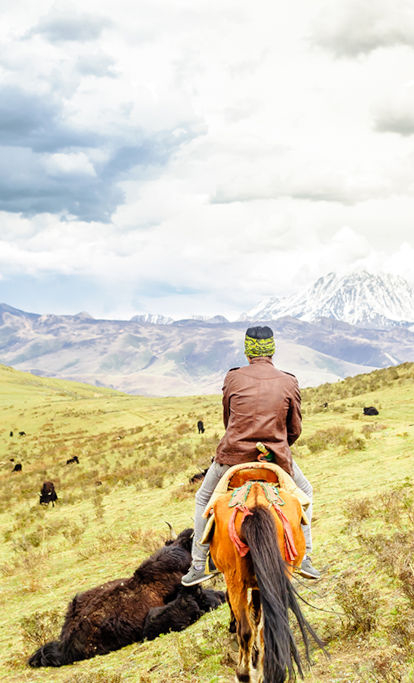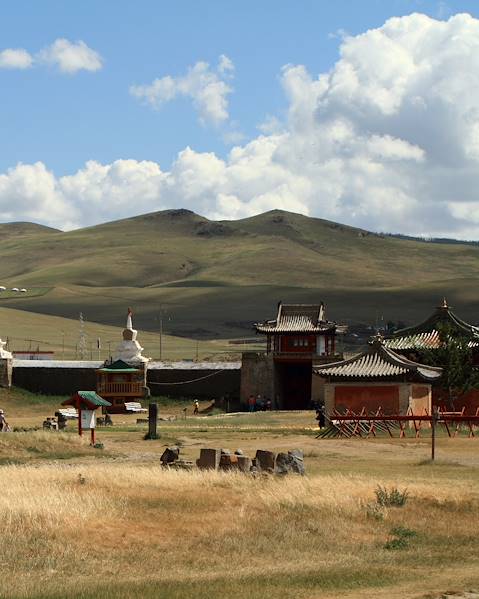Population
3.348 million inhabitants (2021)
Official language
Khalkha Mongolian
Languages spoken
There are a variety of dialects spoken throughout the country, including Oirat and Buryat, as well as some speakers of Mongolic Khamnigan. Towards the west of the country, Kazakh and Tuvan (both of which are Turkic languages) are also spoken.
People
The people of Mongolia are largely made up of a Central Asian ethnographic group of closely related tribal people, who reside (for the most part) on the Mongolian Plateau, where they share a common language and nomadic tradition. Their homeland is now divided into the independent country of Mongolia (Outer Mongolia) and the Inner Mongolia Autonomous Region of China. Nowadays most citizens are considered ethnic Mongols, with 5% of the population being Kazakhs, Tuvans, and other ethnic minorities, who are often found in the west.
Religion
Most Mongol people are Buddhists, with the majority being Mahayana Buddhists. The remaining are made up of Muslim, Shamanist, Christian and other smaller religious groups.
National Holiday
January 1: New Year's Day
First day of first lunar month: Tsagaan Sar
Second day of first lunar month: Tsagaan Sar Holiday
Third day of first lunar month: Tsagaan Sar Holiday
March 8: International Women’s Day
June 14: Buddha Day
July 11: Naadam
July 12: Naadam Holiday
July 13: Naadam Holiday
July 14: Naadam Holiday
July 15: Naadam Holiday
First day of first winter lunar month: Genghis Khan’s Birthday
November 26: Republic Day
December 29: Independence Day
Story
The landlocked country of Mongolia, found in east Asia, borders Russia to the north and China towards the south. It is the world's most sparsely populated sovereign nation, as well as the world’s largest landlocked country, with a grassy steppe terrain, mountains in the north and west, and the famous Gobi Desert towards the south. Its capital – Ulaanbaatar – is also its largest city, with around half of the entire country's population living there.
The territory of modern-day Mongolia has been ruled by various nomadic empires, from the Xiongnu, the Xianbei and the Rouran to the First Turkic Khaganate, among others. But the Mongol Empire initially gained its power when Genghis Khan and his sons conquered large parts of Asia and Europe throughout the 13th century. Marco Polo, along with his father and uncle, became the first Europeans to cross the Gobi in about 1275 AD.
In more recent history, the southern part of Mongolia (known as Inner Mongolia) is part of China, while the northern region became independent from China in 1921 with Russia’s help. Mongolia became a communist country in 1924, but in 1990 multiparty elections were held by the people, which resulted in a new constitution of 1992 and the beginning of the transition to a market economy.
Politics
Mongolia is considered to be a semi-presidential representative democratic republic, with a directly elected president. The Mongol people elect the deputies in the national assembly (the State Great Khural), while the president appoints the prime minister and nominates the cabinet on the proposal of the prime minister. The Mongolia constitution also guarantees several freedoms, including full freedom of both expression and religion. Mongolia has several political parties, the largest of which are the Mongolian People's Party and the Democratic Party. The non-governmental organisation Freedom House considers Mongolia to be free.
Etiquette
The Mongolian people are friendly, warm-hearted and sincere. Travellers journeying here will experience this openness and hospitality, which is why it’s important to respect their traditions and etiquette in return. While tipping is not considered conventional, Mongolians working in tourism-related fields (such as guides, drivers and waiters at restaurants) are becoming more open to receiving tips. Hats are particularly important in Mongolian culture, as they protect one of the most sacred body parts; the head. The feet are considered the dirtiest part, hence you should avoid touching a person's head, placing a hand on the back of a chair where someone is sitting or putting your feet on tables or chairs. If you do accidentally touch someone with your foot or touch their head, apologise profusely as a sign of recognition and understanding. It’s also considered impolite to come out directly and ask for something like directions. When it comes to sacred religious sites, shorts, short skirts or hats are not allowed in temples or monasteries. Nor is removing prayer flags or hadag (ceremonial scarf), or anything from an altar or Ovoo (sacred stone shrines). Photography wise, you shouldn’t take pictures without permission and flash should be avoided.
Food
When it comes to food, Mongolians certainly know what they're doing and the simplicity of their ingredients doesn’t mean a compromise on flavour. From meat-based dishes like mutton, beef, camel, horse, sheep and even marmot (a Mongolian rodent), to the carb-tastic and tasty accompaniments of pasta, rice and noodles, you’re sure to find something to satisfy your appetite. There’s Huushuur, small half-moon shaped fried pastries filled with meat and onions, or buuz, large dumplings again filled with meat, onions and garlic before being steamed. Try deep fried noodles known as Chanasan makh (boiled meat with salt), or an authentic Mongolian barbeque called Khorkhog. Sweet toothed fanatics needn’t worry as there’s Gambir (a fried cake) and Boortsog (cookies) to be sampled too.
Drink
The tap water in Mongolia, while it looks clear, is not suitable for drinking unless it has been boiled or filtered by a jug. Tourist sites, hotels and restaurants will sometimes offer clean drinkable water but be sure to double check this is safe to consume. Thankfully Mongolia also champions the homemade drink; from the healing properties of the Sea Buckthorn juice or liquid gold, to the fermented dairy drink Airag, a round of applause awaits anyone who can down an entire cup. Milk tea and vodka are also firm favourites.














